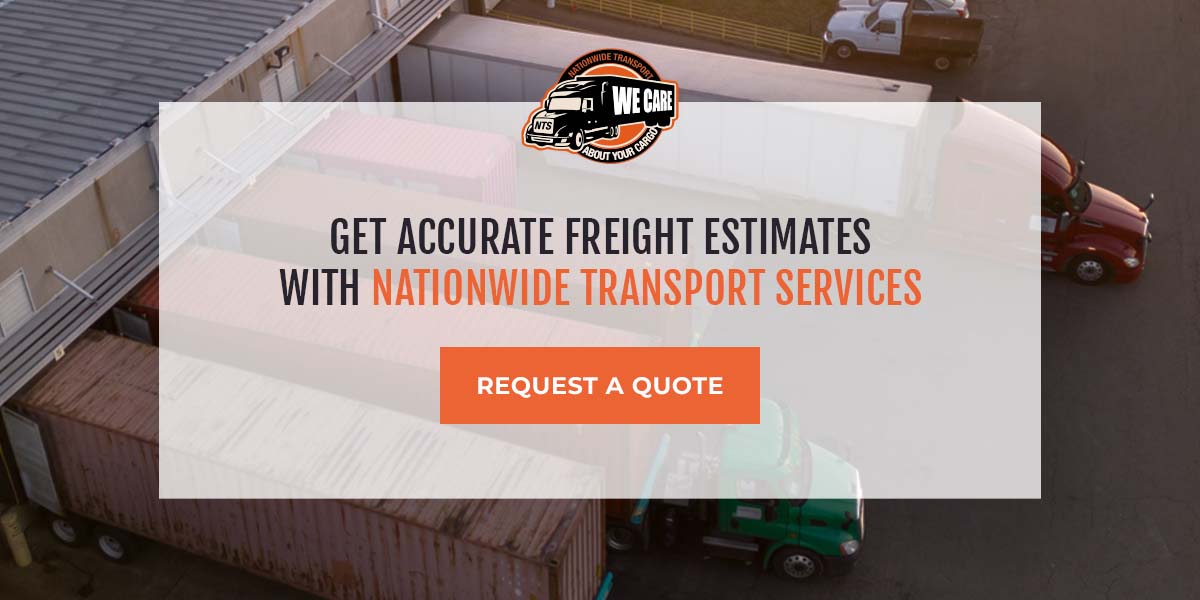Freight costs are one of the biggest variables, whether you’re managing a tight budget, coordinating large hauls across state lines or simply trying to avoid unexpected surcharges. Determining what those costs will be isn’t always straightforward. Freight pricing depends on several moving parts, including distance, cargo type and fuel rates. Miscalculations can lead to delays, lost revenue or unhappy clients.
Below, we’ll explore how freight calculators work, what influences shipping costs and how to get the most reliable estimates possible.
What Is a Freight Calculator?
A freight calculator, also called a freight rate estimator or truck freight calculator, is a digital tool that estimates shipping costs based on key variables, including:
- Origin and destination ZIP codes.
- Distance traveled.
- Cargo weight and dimensions.
- Mode of transportation.
- Fuel surcharges.
- Additional services, like load assistance or pilot cars.
Who Should Use a Freight Calculator?
If you’re involved in moving goods or equipment, either occasionally or daily, a freight calculator can save you time, money and headaches. It’s beneficial for:
- Logistics managers overseeing routine or high-volume shipments.
- Construction companies transporting heavy equipment.
- Small businesses shipping products across the country.
- Agricultural operations hauling seasonal machinery.
Factors Affecting Freight Rates
Freight pricing isn’t static. Rates can vary based on a few key factors, such as:
- Distance and route: Longer hauls generally cost more, but route complexity also matters. For example, remote destinations, limited-access roads or heavy urban traffic can increase your rate.
- Weight and dimensions: The carrier’s price is based on volume and weight. Heavier or bulkier items may require special trailers, permits or escorts, all of which add to the cost.
- Freight class: If you’re shipping less than truckload (LTL), your cargo will be assigned a freight class based on density, handling, stowability and liability. A higher class typically means a higher price.
- Mode of transport: Full truckload (FTL), LTL and flatbeds all have different costs based on the level of service and equipment required.
- Urgency: Expedited shipments usually come at a premium. The more lead time you can provide, the more affordable your options will be.
- Fuel surcharges: Carriers may add fuel surcharges to account for fluctuating diesel prices, which can shift weekly.
Step-By-Step Guide to Using a Freight Rate Estimator
Using a freight calculator isn’t complicated, but getting an accurate estimate means entering the correct information, which typically includes:
- Pickup and delivery locations.
- Cargo details.
- Mode of transport.
- Specifying any extras.
- Getting a final quote.
Freight rates vary across industries, regions and time frames. U.S. international import and export price indexes vary, depending on multiple factors:
- Freight type
- Shipping lane
- Freight availability
How Freight Rates Fluctuate Over Time
Several factors cause freight rates to rise or fall:
- Fuel prices: A sudden spike in fuel prices may translate to higher fuel surcharges.
- Seasonal demand: Peak seasons like retail holidays or construction booms can stretch carrier availability and drive up prices.
- Economic shifts: Changes in consumer demand, labor availability or port activity can impact freight volumes and pricing.
- Weather and disruptions: Hurricanes, snowstorms and wildfires can close routes or delay hauls, tightening capacity and pushing rates upward.
- Regulatory changes: New emissions standards, insurance requirements or hours of service regulations can increase carriers’ costs, which may be passed along to shippers.
How Distance Impacts Shipping Charges
Most carriers charge by the mile, but the cost per mile can vary based on several distance-related factors:
- Total mileage: More miles usually means higher total cost, but sometimes the rate per mile drops slightly for longer hauls due to route efficiency.
- Route complexity: A straight shot down a major interstate is cheaper than navigating back roads, steep inclines or restricted urban areas.
- Cross-border fees: International freight may require customs clearance and paperwork, adding to both distance-based and administrative expenses.
Tools for Accurate Distance Measurement
Some tools and methods help ensure mileage is calculated correctly:
- Freight-specific route planning tools: These account for road restrictions, low bridges, tolls and commercial vehicle rules that GPS apps might miss.
- Department of Transportation (DOT) route maps: DOT route guides show approved roads for heavy hauls and oversized loads.
- Carrier input: If you’re working with a carrier, they may suggest alternate routes that are more fuel-efficient or safer for certain types of freight.
How to Calculate Freight Cost
Freight pricing models generally fall into two categories:
- Weight-based pricing: Carriers charge by the total weight for dense, heavy items like steep parts or machinery.
- Volume-based pricing: For bulky but lightweight items like foam insulation or plastic tanks, carriers charge based on how much space the cargo occupies.
This is where dimensional (DIM) weight comes into play. DIM weight is calculated using this formula:

Length × Width × Height ÷ DIM Factor
Carriers then compare the actual weight to the DIM weight and charge based on whichever is higher. This pricing model ensures that oversized but lightweight freight doesn’t take up valuable space for less money.
Handling Oversized or Overweight Freight
Shipments that exceed standard trailer limits are classified as oversized or overweight. These loads may require:
- Specialized trailers like lowboys or extendable flatbeds.
- Permits issued by state or local transportation departments.
- Pilot cars or escort vehicles for road safety.
- Route planning to avoid overpasses, tight turns or weight-restricted roads.
How Fuel Prices Affect Shipping Costs
When fuel prices rise, so do freight costs. However, carriers apply a fuel surcharge to cover the difference rather than updating base rates every time gas goes up a few cents. This surcharge is typically calculated as a percentage of the line haul. It adjusts in response to changes in fuel market indexes, like the U.S. Energy Information Administration’s (EIA) weekly diesel average.
Typical Surcharge Calculation Methods
Common ways surcharges are calculated include:
- Flat-rate surcharge: A fixed percentage added to all shipments regardless of fuel cost trends.
- Index-based surcharge: Tied to a fuel price index, often updated weekly or monthly.
- Mileage-based surcharge: An added amount per mile driven, regardless of the total shipment value.
What Freight Insurance Covers
Freight insurance covers loss or damage to your shipment in transit. Depending on the policy and the carrier, coverage may include:
- Damage from accidents, collisions or shifting loads.
- Theft or loss during transit.
- Weather-related damage.
- Handling damage during loading and unloading.
Common Additional Costs to Watch For
Some typical extra charges may not be included in an initial estimate:
- Liftgate service: If there’s no load dock at pickup or drop-off, you may need a liftgate-equipped truck to handle the freight safely.
- Residential delivery fees: Shipping to a home often triggers a residential surcharge due to restricted access or limited equipment.
- Limited-access locations: Schools, military bases, construction sites and government buildings may incur added fees due to delivery challenges.
- After-hours delivery: Deliveries made outside regular business hours often incur an additional charge.
Tips to Avoid Unexpected Charges
Being proactive and clear about your shipment needs can help prevent surprise costs. Here’s how:
- Confirm pickup and delivery locations.
- Provide accurate cargo details.
- Clarify the services needed.
- Ask for an all-in quote.
Get Accurate Freight Estimates With Nationwide Transport Services
Accurately calculating freight costs is one of the most essential yet challenging steps in your shipping process. Between fuel surcharges, dimensional pricing, hidden fees and fluctuating market rates, it’s easy to feel overwhelmed or unsure if you’re getting a fair price.
This is why working with a dedicated logistics expert makes all the difference. At Nationwide Transport Services, we understand how much is riding on every shipment. Whether you’re moving construction equipment, agricultural machinery or essential freight for your business, our freight shipping experts will work with you to get the most accurate estimate possible. We’ll help simplify the process so you can focus on other important areas of your business.
Contact Nationwide Transport Services today if you’re ready to find a supportive freight shipping partner.
